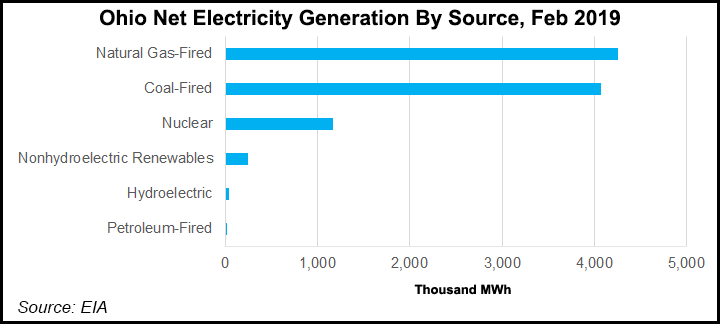Regulatory | Infrastructure | NGI All News Access
Ohio Inches Toward Nuclear Subsidies as Legislation Clears House
The Ohio House of Representatives has passed a bill to subsidize the state’s two nuclear power plants in a move decried by the natural gas industry, which has staunchly opposed out-of-market assistance for the reactors operated by bankrupt FirstEnergy Corp. subsidiaries.

House Bill (HB) 6 now moves to the state Senate, where many expect the legislation to pass after it breezed through the House following introduction in April. The legislation cleared the House by a vote of 53-43, with 10 Democrats joining 43 Republicans to approve it. Last minute amendments would limit property tax devaluation on the plants and cap subsidies for them if electricity prices rise.
As written, it would eliminate the state’s renewable portfolio standards, which require utilities to procure 12.5% of their power from renewable sources by 2027, scrapping the $4.39 monthly charge electricity customers pay for the mandates in favor of a lower charge to help fund a “clean air” program. The monthly fee paid by residential, commercial and industrial customers is now estimated to generate about $190 million annually, most of which would go toward the nuclear plants.
Nuclear and existing solar power are the only qualifying “clean air” resources in the current version of the bill, unlike previous proposals that would have compensated new wind and solar projects. The bill has drawn criticism from environmental groups and, in particular, gas-fired generators who argue the subsidies would depress energy prices and put them at a competitive disadvantage. But the legislation is still expected to receive support in the state Senate.
“While we see fewer outspoken supporters in the GOP-controlled state Senate, we think sufficient support among Republicans and Governor Mike DeWine’s advocacy for HB 6 could animate approval in the upper chamber,” said analysts at ClearView Energy Partners LLC. “Therefore, we think Ohio enacts a nuclear assistance program before June 26.”
HB 6 advances after similar measures in other states to subsidize nuclear power, including those in Connecticut, Illinois, New Jersey and New York, have succeeded. The battle has spilled into the Appalachian Basin, where unconventional drilling in Ohio and Pennsylvania combined to produce more than 8 Tcf of natural gas last year.
Legislation was introduced earlier this year in Pennsylvania that would make nuclear power a qualifying resource under Pennsylvania’s Alternative Energy Portfolio Standards. But bills in both chambers are stuck in committee and for now are said to be without the necessary support to progress.
Among the last minute amendments to HB 6 that drew additional criticism from detractors is a stipulation that would allow utilities to charge monthly fees to recover their ownership stake in two Ohio Valley Electric Corp. coal-fired power plants in southern Ohio and southeast Indiana.
“While bailing out just the two nuclear power plants represented a large government intrusion into the private market, embracing an additional bailout of two coal-fired power plants, including a plant in Indiana, sends a signal that Ohio is mired in the past, addicted to uneconomic subsidies, and not interested in competition or the benefits of a free market,” said Peter Rigney, president of the Ohio Independent Power Producers (OIPP) board.
Chris Zeigler, executive director of API-Ohio, said the legislation disadvantages natural gas and other power generators that have delivered savings and also cleaner air in the state over the last decade.
“Ultimately, this legislation hurts the Ohio consumer,” Zeigler said. “We urge the Senate to protect Ohio taxpayers and reject this legislative bailout.”
Low cost gas has made it hard for nuclear facilities to compete in wholesale power markets. Dozens of gas-fired facilities have entered service or are under construction across Appalachia. In Ohio alone, gas-fired generators have invested $11 billion to build more than 11,000 MW of capacity, according to OIPP.
But the bill’s proponents have argued in favor of the steady baseload power nuclear facilities provide and the jobs they’ve created. Ohio’s two reactors generate about 15% of the state’s electricity and nearly 89% of its emissions-free power, according to the Nuclear Energy Institute (NEI).
The Davis-Besse and Perry plants, owned by FirstEnergy Solutions Corp., employ more than 1,400 workers and pay over $20 million in taxes, according to NEI. FirstEnergy Solutions filed for bankruptcy last year, citing the prolific natural gas supplies in Appalachia that have eroded profits from power sales. The company is still working through those proceedings and has already announced plans to close Davis-Besse and Perry absent any legislation or market reforms.
© 2024 Natural Gas Intelligence. All rights reserved.
ISSN © 1532-1231 | ISSN © 2577-9877 |
